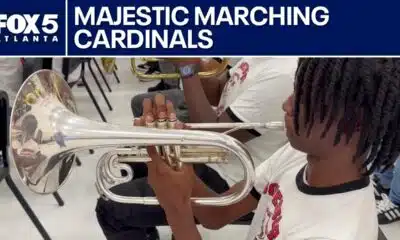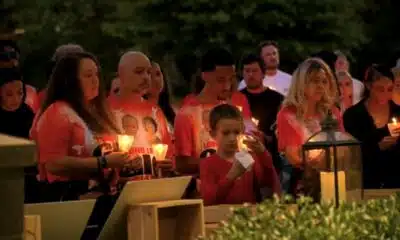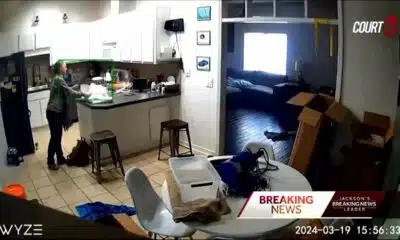News from the South - West Virginia News Feed
FEMA’s refusal to help some West Virginia counties just a taste of what’s to come
by Leann Ray, West Virginia Watch
April 29, 2025
Last week, West Virginia Watch reporter Amelia Ferrell Knisely traveled to McDowell County to talk to residents about recovery efforts after the mid-February floods.
She found that many people still have soggy carpets and wet basements after more than two months. Houses are filled with mold. Trash is piled up outside. Some residents say they haven’t seen anyone from the state or federal government in their small towns offering help.
And McDowell is one of the few counties that actually received federal funding for flood response.
In late February, the federal government approved Gov. Patrick Morrisey’s request for federal aid. The Federal Emergency Management Agency has so far approved nearly 3,500 applications for individual assistance, and more than $25 million has been awarded to residents in Logan, McDowell, Mercer, Mingo, Raleigh, Wayne and Wyoming counties.
Residents who receive that money can use it to cover the costs of temporary housing and home repairs.
About 94% of West Virginia communities are considered “Special Flood Hazard Areas,” which means the more than 84,000 structures in those areas are at a high risk of flooding, according to a 2023 report by researchers at West Virginia University.
However, President Donald Trump has suggested that FEMA, which is the only agency currently that administers disaster relief funds, might “go away.”
Last week it was announced that Elon Musk’s Department of Government Efficiency would cut 1,000 employees — or 20% of the workforce — from FEMA, just ahead of hurricane season.
On Wednesday, Morrisey announced that FEMA denied individual assistance grants to Boone, Cabell, Greenbrier, Kanawha, Lincoln, Monroe and Summers counties, and public assistance grants in Cabell and Kanawha counties for the February floods.
“Despite today’s notification, I am grateful to the Trump Administration for their strong support for Southern West Virginia’s recovery following the February floods,” Morrisey said in a statement.
We know you’re not a native West Virginian, governor, but please stand up for your adopted state.
Alex Brown from Stateline, one of West Virginia Watch’s sister newsrooms, reached out to the White House about states being denied FEMA funding, and received a statement that said the agency is focused on “truly catastrophic disasters,” and that states need to have a better “appetite to own the problem.”
West Virginia has no appetite, as shown during the legislative session.
On April 4, about three weeks after the devastating February floods, Del. Sean Hornbuckle, D-Cabell, proposed adding $50 million to the state budget for flood prevention.
“We have the ability to do something earthly,” Hornbuckle said. “The power that we have — not just the divine power — but with a button and a pen that we all have to help out neighbors in the great state of West Virginia.”
The amendment was rejected 75-19.
Remember the 2016 floods — the deadliest in the state’s history? Former Gov. Earl Ray Tomblin, a Democrat born in Logan County, declared a state of emergency for 44 of the state’s 55 counties.
Since November 2019, FEMA has given West Virginia more than $424 million in funding in response to the 2016 floods. More than $42 million was given to 4,949 individuals and families, and more than $172.8 million was given to local and state governments and some nonprofits. FEMA also provided more than $209.8 million to replace Herbert Hoover High, Richwood Middle, Richwood High, Summersville Middle and to relocate Clendenin Elementary.
Herbert Hoover High School was destroyed, and students were taught in portable classrooms until their new school was completed in fall 2023. Clendenin Elementary School didn’t reopen until fall 2024. Construction hasn’t started on the schools destroyed in Nicholas County.
In response to that flood, the West Virginia Legislature created the State Resiliency Office. Its purpose is to “Minimize the loss of life and property, maintain economic stability, and improve recovery time by coordinating with stakeholders to implement disaster resilient strategies.
The state Legislature created the West Virginia Disaster Recovery Trust Fund in 2023 with Senate Bill 677. The fund sits empty. No money was allocated to that fund during the 2024 legislative session. The FY 2026 budget, which Morrisey has signed, doesn’t include any money for the fund either.
There were only three bills related to flooding during the session — House Bill 2858 and Senate Bill 502 were the same bill, meant to allow counties to regulate floodplains under National Flood Insurance Program guidelines. They both died. House Bill 3502, sponsored by Hornbuckle, would have allowed a one-time allocation of $100 million from the state revenue shortfall fund and $150 million from the state’s income tax revenue fund for the West Virginia Flood Resiliency Trust Fund. It died in the House Government Organization.
West Virginia needs FEMA, but with FEMA potentially out of the picture, it’s time the state whet its appetite and take a bite out of the problem.
Morrisey has already said he plans to call a special session this summer to deal with the Public Employees Insurance Agency and education funding. Sounds like the perfect time and a good use of tax payer money to move some funding over to the West Virginia Disaster Recovery Trust Fund.
GET THE MORNING HEADLINES.
West Virginia Watch is part of States Newsroom, a nonprofit news network supported by grants and a coalition of donors as a 501c(3) public charity. West Virginia Watch maintains editorial independence. Contact Editor Leann Ray for questions: info@westvirginiawatch.com.
The post FEMA’s refusal to help some West Virginia counties just a taste of what’s to come appeared first on westvirginiawatch.com
Note: The following A.I. based commentary is not part of the original article, reproduced above, but is offered in the hopes that it will promote greater media literacy and critical thinking, by making any potential bias more visible to the reader –Staff Editor.
Political Bias Rating: Center-Left
This content reflects a center-left political bias as it highlights government and federal aid shortcomings in disaster response and recovery, particularly criticizing Republican leadership and policies, such as those associated with former President Trump and West Virginia Governor Morrisey. It underscores the need for more proactive state intervention and funding to support vulnerable communities, especially in the context of disaster resilience. The critique of budget decisions and FEMA staff cuts aligns with a perspective that supports stronger public sector involvement and social responsibility, typical of center-left viewpoints, without veering into extreme or partisan language.
News from the South - West Virginia News Feed
Ohio neighborhood fears landslide as retaining wall slips
SUMMARY: In Portsmouth, Ohio, a retaining wall has been slipping for about five years, causing fear among residents like the Yuri family who moved in just before the slip began. Despite support beams installed two years ago, cracks in the wall allow water to gush through, flooding parts of the road and raising concerns about a potential catastrophic landslide. Local councilman Shawn Dun highlights questions about the wall’s stability and estimates repair costs near $2 million, with the city seeking grants to fund the work. Residents anxiously await repairs, hoping the problem will be resolved soon to prevent disaster.
A cloud of concern hovers over one Portsmouth neighborhood. Those living along Richardson Road wonder how much longer a retaining wall will hold and keep a hillside from sliding that would damage their property. The support wall began slipping 5 years ago. A couple years later, support beams were put in place for a problem that those living along the street say is a ticking time bomb.
FULL STORY: https://wchstv.com/news/local/a-ticking-time-bomb-has-a-portsmouth-neighborhood-living-in-fear
_________________________________________
For the latest local and national news, visit our website: https://wchstv.com/
Sign up for our newsletter: https://wchstv.com/sign-up
Follow WCHS-TV on social media:
Facebook: https://www.facebook.com/eyewitnessnewscharleston/
Twitter: https://twitter.com/wchs8fox11
Instagram: https://www.instagram.com/wchs8fox11/
News from the South - West Virginia News Feed
Christian's Latest Forecast: More Dry Days; Rain Potential Late Next Week
SUMMARY: Storm Watch meteorologist Christian Boler reports mild, mostly dry weather continuing through the weekend with temperatures around 80°F and partly cloudy skies. A high-pressure system will maintain these warm, dry conditions into early next week. Some unorganized tropical rainstorms may bring isolated showers from Tuesday night into Wednesday morning, followed by a dry midweek. Saturday promises significant rainfall, helping to relieve recent dry and minor drought conditions affecting vegetation. Temperatures have shifted from below to above average this week but will dip below average later in the month. Overall, expect more dry days with rain potential late next week, improving moisture levels regionally.
FOLLOW US ON FACEBOOK AND TWITTER: https://facebook.com/WOAYNewsWatch https://twitter.com/WOAYNewsWatch.
News from the South - West Virginia News Feed
Road-widening project gets completion date, property issues remain unclear
SUMMARY: The Cross Lanes road-widening project, expanding Route 622 from Golf Mountain Road to Route 62 near Andrew Jackson Middle School, has resumed after a ten-month pause. Originally set for completion in June 2025, the new completion date is February 2027 due to delays caused by utility pole relocations. Construction is causing traffic congestion, especially around the Kroger turning light, which is being studied for timing adjustments. Despite frustrations, officials emphasize the long-term benefits. Property issues, including damage claims and easements, remain unresolved. Kanawha County lawmakers continue to provide updates as the project progresses.
Source
-
News from the South - Alabama News Feed7 days ago
Alabama lawmaker revives bill to allow chaplains in public schools
-
News from the South - Missouri News Feed7 days ago
Pulaski County town faces scrutiny after fatal overdose
-
News from the South - Arkansas News Feed7 days ago
Arkansas’s morning headlines | Sept. 9, 2025
-
News from the South - Texas News Feed7 days ago
‘Resilience and hope’ in Galveston: 125 years after greatest storm in US history | Texas
-
News from the South - Arkansas News Feed6 days ago
Group in lawsuit say Franklin county prison land was bought before it was inspected
-
News from the South - Kentucky News Feed5 days ago
Lexington man accused of carjacking, firing gun during police chase faces federal firearm charge
-
Mississippi News Video6 days ago
Carly Gregg convicted of all charges
-
Mississippi News Video6 days ago
2025 Mississippi Book Festival announces sponsorship













































